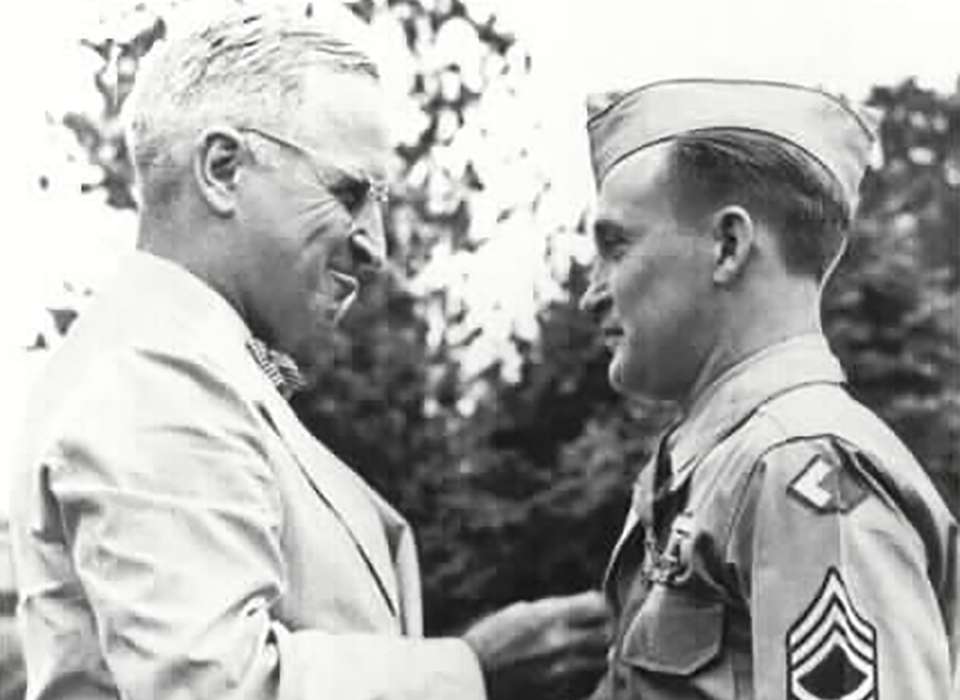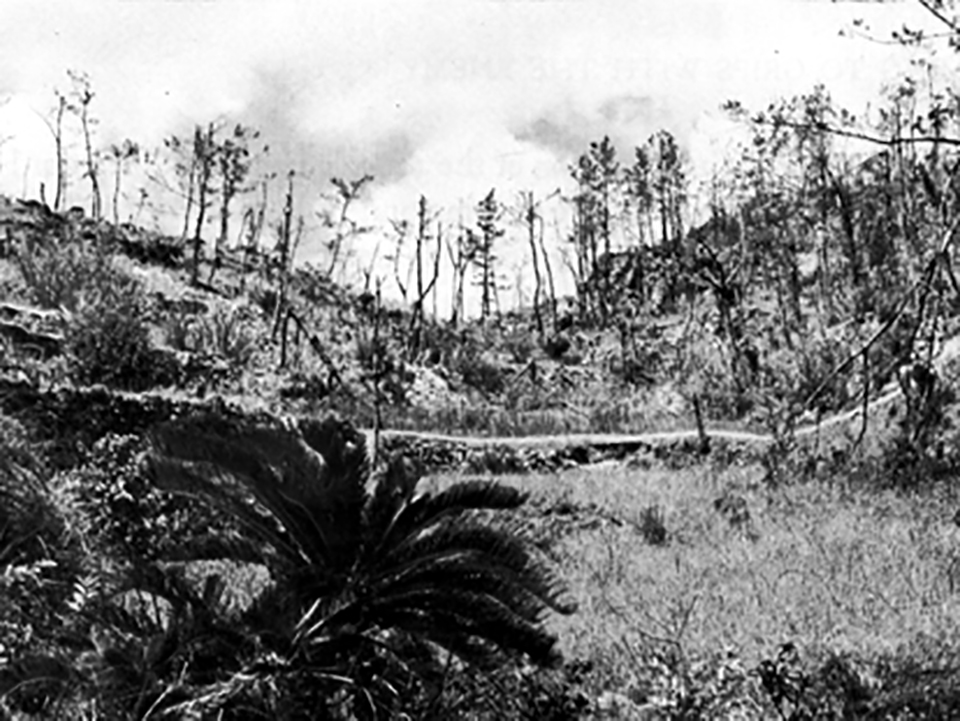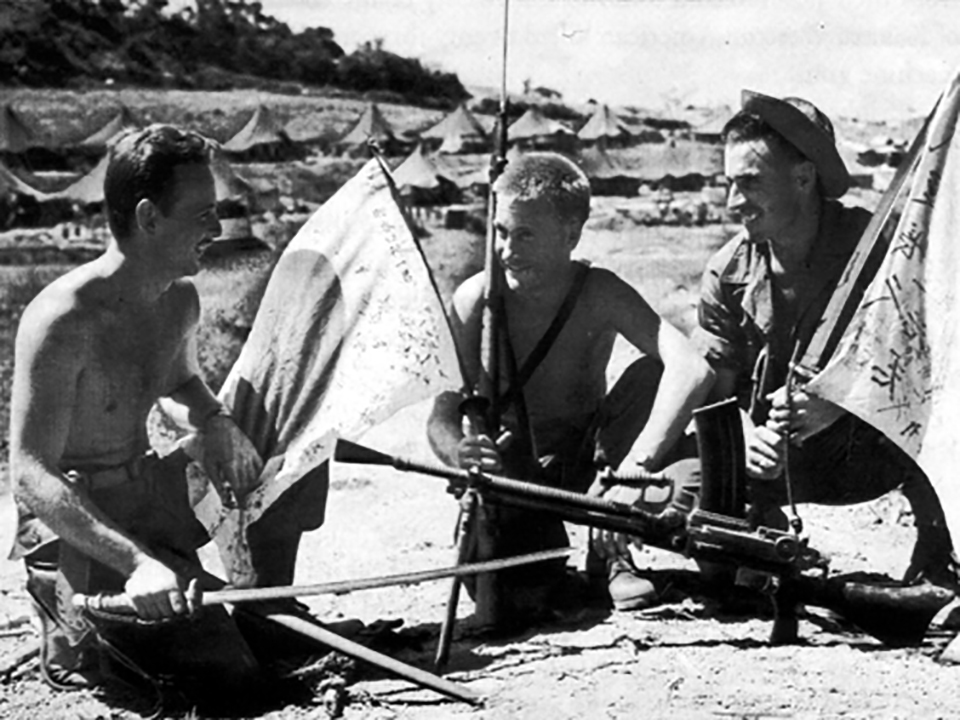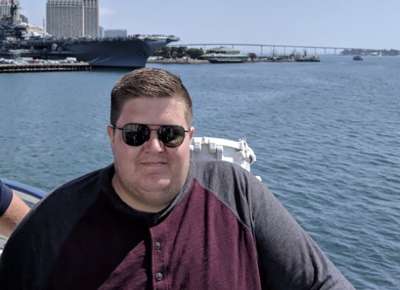Under a cloudless sky on Easter Sunday morning, April 1, 1945, the US Army’s 381st Infantry Regiment of the 96th Infantry Division—the “Deadeyes”—landed on the western shore of Okinawa. Among the assaulting masses was Staff Sergeant Beauford Theodore “Andy” Anderson, a mortarman in 1st Battalion. His regiment was combat tested, made up of veterans of the brutal fight to liberate the Philippines from the Japanese in late 1944. Now, Sgt. Anderson and his men were part of the largest amphibious operation in the Pacific, only 340 miles from the Japanese home islands.
Ahead of the Deadeyes and their fellow divisions of the Tenth Army was some of the toughest fighting of the war. With no available flanking routes, the Americans needed to push directly into the teeth of the enemy’s prepared defenses in southern Okinawa to take the main Japanese positions at Shuri. It would require brutal close-in fighting and punishing firepower. Daily progress would be measured in yards.
The 22-year-old Sgt. Anderson was a calm and unassuming leader who had already proved his courage in battle on the island of Leyte. Crossing open ground under enemy fire, he had pulled two wounded soldiers to safety and provided first aid until they could be evacuated, actions for which he received the Bronze Star. Anderson actually considered Army life somewhat comfortable. “Nobody likes being shot at,” he reasoned. “But I didn’t even know what a day off was before I went into the Army.” As the owner of a small business before enlisting in October 1942, the young man worked tirelessly to keep his fleet of three trucks operating. Hauling dairy products and farm equipment on dirt back roads and through lengthy Wisconsin winters, Anderson was familiar with long days of hard effort. Even basic training’s 16-18 hour-per-day schedule was still not as difficult as his civilian life, he later claimed.
Sergeant Anderson’s 381st Infantry and its sister regiments encountered their first major stumbling block on Okinawa at the outer defenses of the Machinato Line, becoming stalled at Kakazu Ridge. By outward appearances, the 1,000-yard-long ridgeline was not a daunting obstacle. The well-prepared Japanese were dug in deeply, however. When the 96th Division launched its first assault at 5:00 am on April 9, it was unknowingly entering a nightmarish cauldron. The full force of the ridge’s defensive network fell upon the entire regimental front, bringing murderous fire. The fighting quickly turned into desperate hand-to-hand combat.
For days, the 96th Division repeatedly assaulted the ridge. On April 12, Anderson’s battalion attacked Kakazu Ridge three times. Into the teeth of prearranged mortar and machine gun fire, along with small arms fire, satchel charges, and grenades, the Americans made no progress. As evening settled into night, an enormous hours-long artillery and mortar barrage began across the entire 96th Division front, more intense than anything the enemy had fired in the daylight. The rounds eventually shifted to the division’s rear areas, signaling the start of a coordinated enemy counterattack against the 381st and 383rd Infantry Regiments.
In the dark, elements of a reinforced battalion stealthily climbed the south slope and moved down a draw that separated Kakazu Ridge and Kakazu West in a bid to break through the American lines. Little in the saddle stood in their way, except for a mortar squad on Company A’s vulnerable flank led by Sgt. Anderson. At 3:00 am, a column of 75 Japanese soldiers crashed into the surprised Americans. Taking cover from the grenades, knee mortars, and satchel charges, Anderson guided his men into one of the sturdy Okinawan tombs that dotted the landscape. All were wounded, but some were still able-bodied. Still, he ordered his men to shelter there. Then the diminutive 5-foot-7, 130-pound sergeant disappeared back into the dark to take on the enemy alone.
As the Japanese pushed the attack down the saddle, Anderson engaged the column point-blank with only an M1 carbine and some grenades. He fought back against fanatical charges, but was quickly out of grenades. Desperate, Anderson grabbed a dud enemy mortar round and threw it back at the Japanese soldiers, killing several in the explosion. That gave him an idea. Locating his squad’s ammunition in the inky blackness, he opened a box of 60mm mortar rounds and pulled the safety pin on one. Banging the projectile’s base on a rock to arm it, he threw it football-style into the enemy ranks. The blinding flash and loud crack brought screams. He started an alternating pattern, hurling a shell and then firing his carbine. Before the counterattack stopped, Sgt. Anderson had thrown 14 mortar rounds into the enemy’s ranks.
The saddle between Kakazu Ridge and Kakazu West. At left is the tomb that Anderson’s mortar squad used for cover during the enemy’s nighttime attack on April 12-13. US Army photograph.
As dawn broke, the Japanese began pulling back toward the south slope. The growing light revealed not only had Anderson held back the entire attacking enemy force in the saddle, but in the fray he killed 25, protecting his unit’s exposed flank. Bleeding badly from a severe shrapnel wound, he refused evacuation. Against the protests of his men, Anderson again set off alone, this time to find his company commander to report the enemy’s retreat. With the help of Anderson’s information, American artillery wiped out the remaining Japanese attacking force. For his actions on Kakazu Ridge, Sgt. Anderson received the Medal of Honor, one of only five 96th Infantry Division soldiers, and the last from Wisconsin, honored with the award during World War II.
Sergeant Beauford Anderson (middle) shows off trophies of war from the night he stopped a Japanese counterattack in the saddle between Kakazu Ridge and Kakazu West. US Army photograph.
Those close to Anderson claimed he faced the enemy attack alone to protect his men, unwilling to order them to do something he would not take on himself. In later years he was more direct, reflecting that during “a crisis, it’s either do something, or else.” As a mark of his humble nature, some people who knew Anderson for 40 years had no clue about his war service, let alone his Medal of Honor. “I’ve lived the same life as anyone else,” he claimed. “I’m very proud of the fact I’ve got it, but I don’t dote on the fact I’ve got it.”
After his discharge from the Army, Anderson settled in Beloit, Wisconsin, quickly starting a floor sanding business and getting married. In 1948, he reenlisted in the Army and was eventually assigned to Fort Ord, California. Serving in the Korean War, he left the active Army again in 1952 and served in the Army Reserve, eventually earning a commission to second lieutenant. Staying in California, in 1954 Anderson started another floor and wall covering business in Seaside, leading him into local politics in 1963. In 1967, he moved to a 1,200-acre ranch on the edge of Fort Hunter Liggett, where he and his wife raised cattle for 22 years. Retiring in 1989 due to the effects of emphysema, he spent his last years outside Salinas, California. On November 7, 1996, Beauford Anderson died. Only six weeks later, his wife, Phyllis, passed away. Their remains are interred next to each other at Arlington National Cemetery.
Medal of Honor Citation
“He displayed conspicuous gallantry and intrepidity above and beyond the call of duty. When a powerfully conducted predawn Japanese counterattack struck his unit’s flank, he ordered his men to take cover in an old tomb, and then, armed only with a carbine, faced the onslaught alone. After emptying one magazine at point-blank range into the screaming attackers, he seized an enemy mortar dud and threw it back among the charging Japs, killing several as it burst. Securing a box of mortar shells, he extracted the safety pins, banged the bases upon a rock to arm them and proceeded alternately to hurl shells and fire his piece among the fanatical foe, finally forcing them to withdraw. Despite the protests of his comrades, and bleeding profusely from a severe shrapnel wound, he made his way to his company commander to report the action. TSgt. Anderson’s intrepid conduct in the face of overwhelming odds accounted for 25 enemy killed and several machine guns and knee mortars destroyed, thus singlehandedly removing a serious threat to the company’s flank.”
Adam Givens, PhD
Adam Givens is the DPAA Research Partner Fellow at The National WWII Museum and earned his PhD from Ohio University.
Cite this article:
MLA Citation:
APA Citation:
Chicago Style Citation:







![Max Fuchs, New York City cantor, sings as Rabbi Sydney [sic] Lefkowitz, Richmond, VA, conducts the first Jewish services from Germany.](/sites/default/files/styles/max_650x650/public/2025-10/image1.jpg)



